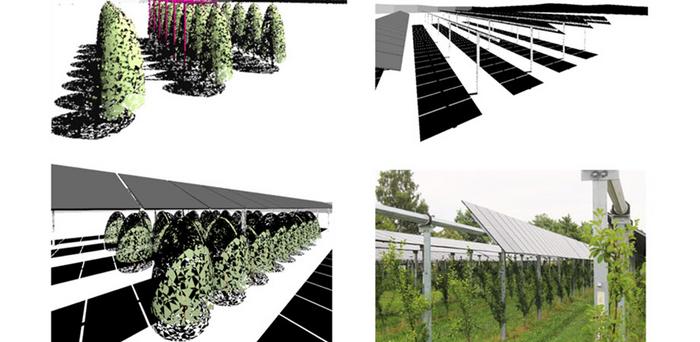Agrivoltaics: A Promising Fusion of Solar Energy and Agriculture
As climate change exacerbates the pressures faced by agriculture, the implementation of agrivoltaic systems can significantly mitigate these impacts. These systems enhance crop resilience by creating a favorable microclimate around the plants. This shading effect, produced by solar panels, can reduce soil temperature and evaporation, thereby decreasing crop water stress and fostering better growth conditions. Insightful research has demonstrated that agrivoltaics can even enhance the productivity of certain crops by supplying them with a unique environmental setting that supports growth while simultaneously generating clean energy.
To maximize the advantages of agrivoltaic setups, researchers are diving deep into advanced tracking systems like Horizontal Single-Axis Trackers (HSAT). By enabling solar panels to tilt and rotate throughout the day, HSAT systems can optimize solar energy capture. This dynamic adjustment is crucial in balancing energy generation with agricultural yield preservation. For agrivoltaic systems to qualify for government subsidies, they must demonstrate a certain level of crop yield retention. Therefore, employing effective tracking strategies is critical not only for sustaining energy output but also for enhancing the economic feasibility of these innovative systems.
A pivotal study highlighted in the Journal of Photonics for Energy elucidates the potential of optimized tracking strategies in agrivoltaics. Researchers concentrated their analysis on apple orchards in southwestern Germany, but their findings possess broader implications for the agriculture sector. Through this study, the research team tackled a crucial question: how can solar panel positions be tailored to serve the specific light requirements of various crops while still producing significant energy output?
In pursuit of answers, the research team developed a cutting-edge methodology aimed at dynamically optimizing solar panel configuration. Distinguishing its approach from conventional shading techniques that typically rely on broader guidelines and fixed structures (like hail nets), this innovative strategy utilizes precise irradiation targets grounded in the unique light requirements of different crop varieties. To assess the implications of varied solar panel configurations on crop light availability, the team utilized a custom simulation tool known as APyV.
APyV employs advanced ray tracing methods to comprehensively analyze solar radiation distribution and its effects on both solar panels and crops. This sophisticated tool facilitates the automated design optimization of agrivoltaic systems based on performance indicators and integrates various crop models into its simulations. With APyV’s direct calculation capabilities, it provides highly accurate evaluations of how light interacts with crops, ultimately portraying the intricate relationship between energy generation and agricultural productivity.
The case study’s outcomes are promising. The research illustrates that with meticulous solar panel management, an impressive 91 percent of the light required by apple trees could be obtained throughout the year, while only incurring a modest 20 percent reduction in overall solar energy yield. Nevertheless, the study also uncovered instances where the light needs of apple trees fell short, indicating the ongoing challenges associated with striking the right balance between crop performance and energy production—challenges that are crucial as more agrivoltaic systems come into play.
Maddelena Bruno, the leading author of the study and a doctoral candidate at Fraunhofer Institute for Solar Energy Systems, emphasizes the vitality of their research. She notes that smart PV tracking systems can capitalize on environmental factors, such as varying weather conditions and fluctuations in crop needs based on growth stages, to optimize the distribution of sunlight available for plants and electricity generation. This dual focus creates an extraordinary opportunity to enhance agrivoltaic efficiency.
As part of the next steps, the proposed irradiation targets and tracking strategies will be tested in real agricultural environments during the current growing season in Nussbach. This field-testing phase holds the promise of providing valuable empirical data to substantiate the theoretical findings collected in the study. Such practical validation is imperative for refining agrivoltaic strategies and enhancing our understanding of their environmental impact, especially concerning apple orchards.
Ultimately, the insights generated from this ongoing research could significantly influence the future of agrivoltaics by directing efforts aimed at optimizing systems that balance agricultural productivity with renewable energy generation. As the world confronts pressing issues of climate change and food scarcity, the ability to harness land for both agriculture and energy becomes an increasingly vital strategy. Recognizing and overcoming the technical challenges within agrivoltaic systems will be essential to facilitate their broader deployment and ensure sustainable practices for future generations.
In conclusion, the integration of renewable energy and agriculture through agrivoltaic systems presents an exciting frontier in efficiency and sustainability. As research progresses, it offers hope for a future where energy production does not compromise food security but rather complements it, enabling a resilient agricultural landscape while advancing the global transition toward renewable energy sources.
Subject of Research: Agrivoltaics and their optimization for agricultural productivity.
Article Title: Enhancing agrivoltaic synergies through optimized tracking strategies.
News Publication Date: 27-Jan-2025.
Web References: https://www.spiedigitallibrary.org/journals/journal-of-photonics-for-energy/volume-15/issue-3/032703/Enhancing-agrivoltaic-synergies-through-optimized-tracking-strategies/10.1117/1.JPE.15.032703.full.
References: M. Bruno et al., “Enhancing agrivoltaic synergies through optimized tracking strategies,” J. Photon. Energy 15(3), 032703 (2025), doi: 10.1117/1.JPE.15.032703.
Image Credits: Bruno et al., doi 10.1117/1.JPE.15.032703.
Keywords: Agrivoltaics, Solar Energy, Agricultural Productivity, Renewable Energy, Environmental Sustainability.
Tags: advanced agrivoltaic technology researchagrivoltaic systemsbiodiversity promotion in farmingclean energy generation methodsclimate change resilience in cropscrop productivity enhancement strategiesecological benefits of agrivoltaicsland-use optimization techniquesmicroclimate effects on agriculturerenewable energy integrationsolar energy in farmingsustainable agriculture practices





